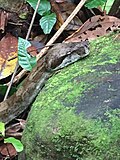| Boa | |
|---|---|
 | |
| Boa constrictor, B. constrictor | |
| Scientific classification | |
| Kingdom: | Animalia |
| Phylum: | Chordata |
| Class: | Reptilia |
| Order: | Squamata |
| Suborder: | Serpentes |
| Family: | Boidae |
| Subfamily: | Boinae |
| Genus: | Boa Linnaeus, 1758 |
| Type species | |
| Boa constrictor Linnaeus, 1758 | |
Boa is a genus of boas found in Mexico, the Caribbean, and Central and South America. Five extant species, and one extinct, are currently recognized. [2]




